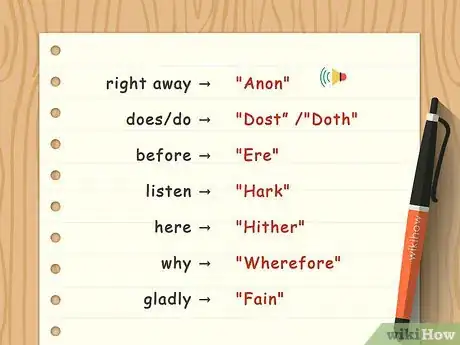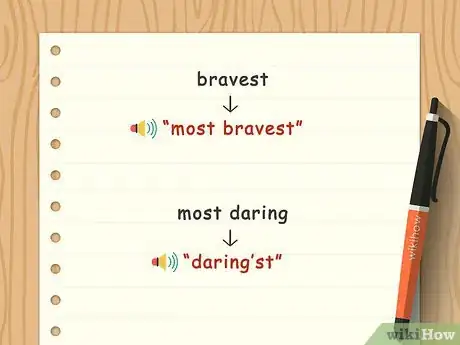This article was co-authored by wikiHow Staff. Our trained team of editors and researchers validate articles for accuracy and comprehensiveness. wikiHow's Content Management Team carefully monitors the work from our editorial staff to ensure that each article is backed by trusted research and meets our high quality standards.
This article has been viewed 432,817 times.
Learn more...
Speaking like Shakespeare can add flair to your conversations and act as a great icebreaker at social events. To pick up this entertaining talent, read some of Shakespeare's most popular plays and sonnets. Recite lines from these works until you feel comfortable with the dense and colourful language. Add Shakespearean words to your vocabulary and speak in the rhythm that makes his language so fun and engaging!
Steps
Learning Shakespeare’s Language
-
1Read Shakespeare’s work. To get a feel for Shakespearean language, read some of his plays or sonnets. Shakespearean language can seem dense, but it is less difficult to understand the more your read. You can find these works at your local library, at bookstores, or online.
- Start with one of Shakespeare's more popular and quintessential works, such as Romeo and Juliet or Hamlet.
-
2Watch a live performance of a Shakespeare play. Seeing Shakespeare’s work performed is an excellent way of familiarizing yourself with his language and how it was meant to be delivered. Look for productions of Shakespearean plays at your local community center, nearby schools, or theatres. You can also visit your local library or look online for recordings of live performances of Shakespeare’s works.
- Be wary of modern interpretations of Shakespeare's plays. Just because a movie has the same name does not necessarily mean that it will follow Shakespeare's script.
Advertisement -
3Recite lines from a Shakespeare play. Reading and reciting lines from Shakespeare’s work will allow you to speak like him. It will also help you recognize distinct rhyming structures and linguistic effects.[1]
- Pay careful attention to punctuation, which is how Shakespeare outlined how he wanted lines to be delivered with the use of commas and other breaks.
-
4Act out Shakespeare plays with family and friends. To truly appreciate the context and power of Shakespeare's dialogue, try acting out his plays with friends or family members. Set up a stage area where the plays will be performed and have people watch your performance if you wish. Be as dramatic as possible and focus on delivering your lines with gusto.[2]
- If you are too shy to act the play out, consider having a read-through instead. A read-through is where you sit with other actors and read your assigned parts from the script.
- You should still act while doing a read-through. Pay attention to the commas, breaks, and exclamation points.
Using Shakespearean Words
-
1Add distinctly Shakespearean words to your vocabulary. The best way to talk like Shakespeare is to use words that are unique to his plays and not found in modern English. These words were used by Shakespeare frequently in his works and stand out as being characteristic of his style. Pepper your everyday speech with words like:
- "Anon," meaning right away.
- "Dost” or "Doth," meaning does or do.
- "Ere," meaning before.
- "Hark," meaning listen.
- "Hither," meaning here.
- "Wherefore," meaning why.
- "Fain," meaning gladly.
-
2Use Shakespearean contractions. In his works, Shakespeare frequently shortened words and phrases to help the flow of dialogue. This linguistic choice also allowed him to maintain iambic pentameter. Add some of these contractions to your regular speech by saying:
- "‘Tis," instead of “it is."
- "'Twas” instead of “it was."
- "Wi’" instead of “with.”
- "O"” instead of “of."
- "'T" instead of “to."
-
3Address people the way Shakespeare would. When speaking to people, call them by names that Shakespeare employed in his writings. For example, when talking to someone, use the pronoun “thou” instead of “you.” Other examples include:[3]
- Men were sometimes referred to as “sirrah.”
- Women were referred to as “mistress.”
- Friends were often affectionately called “cousin.”
-
4Make verbs more Shakespearean. To sound more like Shakespeare, simply amend the end of verbs in sentences. Add the suffix “eth” to verbs to instantly make them more Shakespearean.[4]
- For instance, instead of saying, “He is running to the store”, say, “He runneth to the store.”
-
5Use Shakespearean double superlatives. Superlatives are linguistic tools used to emphasize a higher degree of something in speech. Shakespeare often used double superlatives to create dramatic emphasis. To sound like Shakespeare, amend modern inflections by:
- Adding an adverb to a superlative (e.g., “most bravest” instead of just “bravest.”)
- Replacing the adverb “most” with the suffix “est” or “’st” (e.g., “daring’st” instead of “most daring.”)
Speaking with Shakespearean Rhythm
-
1Speak in iambic pentameter. Shakespeare frequently used iambic pentameter to write dialogue for the more important characters in his plays. To speak in iambic pentameter, use ten syllable lines broken up into five “foots.” In a foot, the first syllable is not stressed, and the second is stressed.
- For instance, say a phrase like, “at once, we must set forth to seize the day” by emphasizing every second syllable (in this case, every second word.)
-
2Use trochaic rhythm. Trochaic rhythm is the opposite of iambic pentameter in terms of the pattern of pronunciation of syllables. Instead of “feet,” trochaic rhythm is comprised of “troches.” Deliver ten syllable lines in two syllable “troches,” with the first syllable being stressed and the second not being stressed.[5]
- A perfect example of trochaic rhythm is the line "Double, double, toil and trouble; fire burn and cauldron bubble" from Macbeth.
-
3Use rhyming couplets. Speak in rhymed couplets to sound distinctively Shakespearean. Shakespeare would group two successive lines with rhyming words at the end of each. Couplets can be grouped together to emphasize the effect (i.e., rhyming last words in lines one and two, with different rhyming words in lines three and four).[6]
- There are many exemplary rhyming couplets in Romeo and Juliet, such as: "Did my heart love till now? Forswear it, sight. For I ne’er saw true beauty till this night."
Community Q&A
-
QuestionHow do I say "you might be correct" when speaking like Shakespeare?
 DonaganTop AnswererPerchance you doth prevail.
DonaganTop AnswererPerchance you doth prevail. -
QuestionHow do you say 'I'm fine'?
 Community AnswerShakespeare rarely used phrases as neutral as "I'm fine", so add some flair to your statement. For example, say, "Ay, I am merry!"
Community AnswerShakespeare rarely used phrases as neutral as "I'm fine", so add some flair to your statement. For example, say, "Ay, I am merry!" -
QuestionHow would I change my play script to make it sound more Shakespearean?
 Community AnswerYou can replace ordinary words with their Shakespearean equivalent, such as "'tis" instead of "it is." You can also use Shakespearean verbs, contractions, greetings, and rhythm.
Community AnswerYou can replace ordinary words with their Shakespearean equivalent, such as "'tis" instead of "it is." You can also use Shakespearean verbs, contractions, greetings, and rhythm.
Warnings
- Don't copy Shakespeare's phrases if you don't know the true meaning. He was known to use double or triple entendres, and some don't have the greatest meaning.⧼thumbs_response⧽
References
- ↑ http://cola.calpoly.edu/~dschwart/engl339/verseprose.html
- ↑ https://owlcation.com/academia/How-to-Teach-Shakespeare-to-Reluctant-Learners
- ↑ http://www.npr.org/2009/04/23/103414533/how-now-wench-talking-like-shakespeare
- ↑ http://www.npr.org/2009/04/23/103414533/how-now-wench-talking-like-shakespeare
- ↑ http://cola.calpoly.edu/~dschwart/engl339/verseprose.html
- ↑ http://cola.calpoly.edu/~dschwart/engl339/verseprose.html
About This Article
Speaking like Shakespeare is a fun way to add flair to any conversation. The next time you’re talking to someone, try peppering some uniquely Shakespearian words into the conversation. You could say “come hither” instead of “come here,” “hark” instead of listen,” or “doth” instead of “does.” Try making your verbs more Shakespearean by adding the suffix “eth” to the end of them. For instance, you might say “He runneth to the store.” If you want to perfect the Shakespeare style, watch one of his plays, or a movie adaptation, to familiarize yourself with the rhythm of the dialogue. Many Shakespeare plays use iambic pentameter. This means the dialogue is broken up into 10 syllable lines with every other syllable being stressed. “At once we must set forth to seize the day” is a good example of iambic pentameter. Try reading some Shakespeare lines out loud or putting on a play with your friends to practice this technique! To learn how to use Shakespearian rhyming couplets, read on!








































































